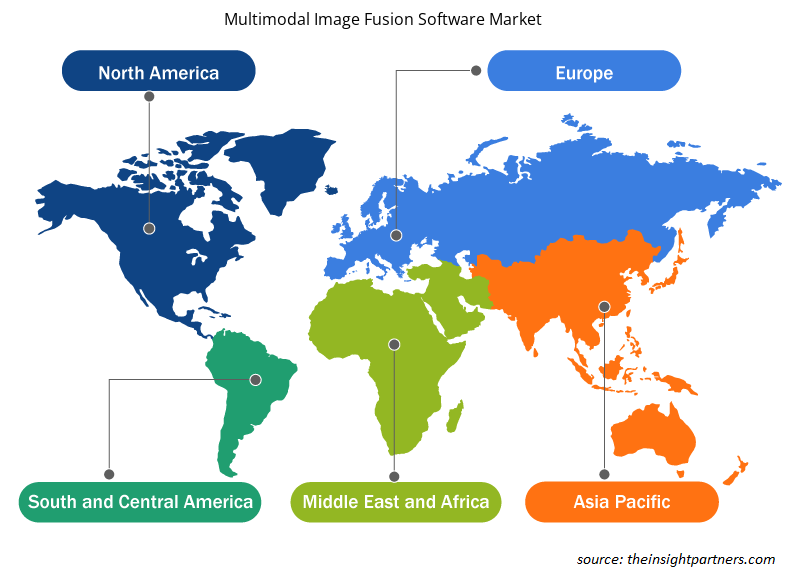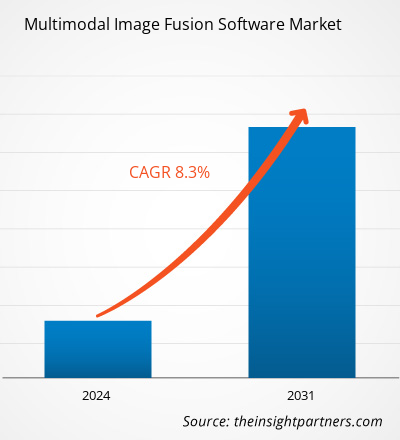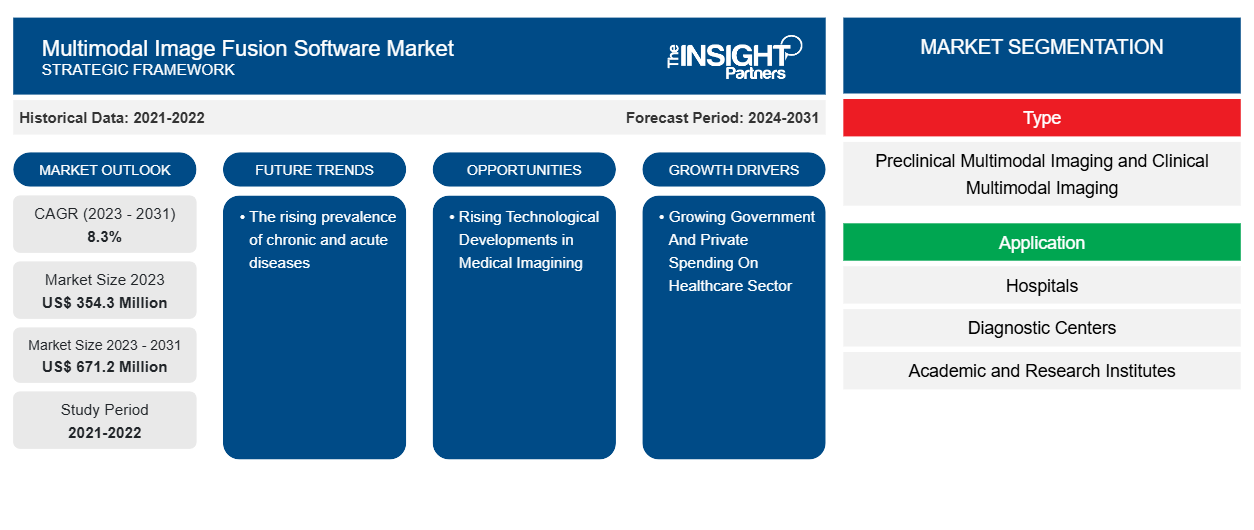Le marché des logiciels de fusion d’images multimodales devrait atteindre 671,2 millions USD d’ici 2031, contre 354,3 millions USD en 2023. Le marché devrait enregistrer un TCAC de 8,3 % au cours de la période 2023-2031. La prévalence croissante des maladies chroniques et aiguës devrait rester une tendance clé du marché.
Analyse du marché des logiciels de fusion d'images multimodales
Les logiciels de fusion d'images multimodales peuvent produire une vue plus complète et plus précise de la scène en fusionnant de nombreuses caractéristiques des données d'imagerie, ce qui facilite la prise de décision et améliore les performances du système de bout en bout. De plus, les données d'imagerie multimodales peuvent faciliter la prise de décision et les performances du système. Le besoin de technologie de fusion d'images multimodales ne cesse de croître en raison de sa large gamme d'applications. Par exemple, en imagerie médicale, la fusion d'images multimodales peut aider à améliorer le diagnostic et la planification du traitement en fusionnant les informations provenant de diverses modalités d'imagerie.
Aperçu du marché des logiciels de fusion d'images multimodales
Les logiciels de fusion d'images multimodales tentent de combiner des informations importantes provenant d'images capturées par plusieurs capteurs en une seule image. Les images fusionnées doivent conserver toutes les informations essentielles des photos d'origine sans introduire de distorsions ni d'artefacts. Les logiciels de fusion d'images multimodales devraient jouer un rôle important dans plusieurs applications, notamment la conduite autonome, les systèmes de surveillance et la robotique. L'intégration de données provenant de nombreuses sources permet à ces systèmes de fonctionner dans des contextes complexes et dynamiques, augmentant ainsi l'efficacité, la fiabilité et la sécurité.
Personnalisez ce rapport en fonction de vos besoins
Vous bénéficierez d'une personnalisation gratuite de n'importe quel rapport, y compris de certaines parties de ce rapport, d'une analyse au niveau des pays, d'un pack de données Excel, ainsi que de superbes offres et réductions pour les start-ups et les universités.
- Obtenez les principales tendances clés du marché de ce rapport.Cet échantillon GRATUIT comprendra une analyse de données, allant des tendances du marché aux estimations et prévisions.
Moteurs et opportunités du marché des logiciels de fusion d'images multimodales
La croissance des dépenses publiques et privées dans le secteur de la santé favorise le marché
Français Les dépenses publiques et privées dans le secteur de la santé augmentent continuellement en réponse à une meilleure santé publique. Par exemple, selon les Centers for Medicare & Medicaid Services des États-Unis, les dépenses nationales de santé (NHE) ont augmenté de 4,1 % pour atteindre 4 500 milliards de dollars américains en 2022, soit 13 493 dollars par personne. Elles représentaient 17,3 % du produit intérieur brut (PIB). Les dépenses de Medicare ont augmenté de 5,9 % pour atteindre 944,3 milliards de dollars en 2022, soit 21 % du total des NHE. 2021. En outre, les parts les plus importantes des dépenses totales de santé aux États-Unis ont été financées par le gouvernement fédéral (33 %) et les ménages (28 %). La part des entreprises privées dans les dépenses de santé représentait 18 % des dépenses totales de santé, les gouvernements des États et locaux représentaient 15 % et les autres revenus privés représentaient 7 %. La fusion d'images multimodales joue un rôle essentiel dans l'industrie médicale. Elle est conçue exclusivement pour l'imagerie médicale. Cette stratégie vise à rendre l'imagerie médicale plus pertinente cliniquement pour l'examen et l'évaluation des problèmes de santé en réduisant le travail inutile et en améliorant la qualité. Elle permet un diagnostic plus précis et rationalise le processus de diagnostic. Dans la fusion d'images médicales (MIF), un ensemble flou intuitionniste (IFS) contribue à améliorer la qualité de l'image, ce qui est utile pour le diagnostic médical. Ainsi, les dépenses croissantes du gouvernement et du secteur privé dans le secteur de la santé stimulent la croissance du marché.
Développements technologiques croissants dans l'imagerie médicale
Les technologies d'imagerie médicale évoluent constamment, ce qui donne lieu à de nouvelles applications pour le diagnostic et le traitement des maladies. Les nouvelles technologies d'imagerie médicale promettent d'améliorer directement les résultats des patients. Les technologies d'imagerie médicale innovantes promettent d'améliorer les résultats des patients de diverses manières. Par exemple, les appareils d'imagerie mobiles peuvent surveiller et diagnostiquer les patients âgés sans nécessiter de séance médicale en personne . Les gadgets médicaux portables qui incluent des composants d'imagerie permettent aux patients de signaler plus facilement et plus facilement des faits vitaux, ce qui permet aux chercheurs médicaux d'exploiter l'intelligence artificielle (IA), la réalité virtuelle (RV), les ordinateurs portables et d'autres avancées technologiques pour améliorer les soins de santé. Les ordinateurs peuvent imiter des circonstances du monde réel de manière à permettre aux humains d'acquérir de nouvelles idées et de nouveaux points de vue qui dépassent leur perception sensorielle. De plus, la fusion d'images multimodales peut aider à détecter et à traiter des troubles complexes en fusionnant des informations provenant de plusieurs modalités d'imagerie telles que la tomodensitométrie (TDM) et l'imagerie par résonance magnétique (IRM).
Analyse de segmentation du rapport sur le marché des logiciels de fusion d'images multimodales
Les segments clés qui ont contribué à la dérivation de l’analyse du marché des logiciels de fusion d’images multimodales sont le type et l’application.
- En fonction du type, le marché des logiciels de fusion d’images multimodales est segmenté en imagerie multimodale préclinique et imagerie multimodale clinique.
- En termes d’application, le marché est segmenté en hôpitaux, centres de diagnostic et instituts universitaires et de recherche.
Analyse des parts de marché des logiciels de fusion d'images multimodales par zone géographique
La portée géographique du rapport sur le marché des logiciels de fusion d’images multimodales est principalement divisée en cinq régions : Amérique du Nord, Asie-Pacifique, Europe, Moyen-Orient et Afrique, et Amérique du Sud et centrale. Alors que les hôpitaux et les prestataires de soins de santé d’Amérique du Nord s’efforcent de numériser leurs procédures, la demande d’entreprises de développement de logiciels de santé qualifiées augmente. Cet article comprend une liste d’organisations de développement de logiciels de santé notables qui sont prêtes à réaliser un changement transformationnel. La région nord-américaine domine l’adoption de logiciels dans le domaine de la santé et dans d’autres domaines, en raison de son taux d’adoption élevé de solutions logicielles médicales innovantes et d’une importante population de patients, ce qui garantit sa domination pendant la période de projection. De tels cas créent des opportunités lucratives pour la croissance du marché.
Aperçu régional du marché des logiciels de fusion d'images multimodales
Les tendances et facteurs régionaux influençant le marché des logiciels de fusion d’images multimodales tout au long de la période de prévision ont été expliqués en détail par les analystes d’Insight Partners. Cette section traite également des segments et de la géographie du marché des logiciels de fusion d’images multimodales en Amérique du Nord, en Europe, en Asie-Pacifique, au Moyen-Orient et en Afrique, ainsi qu’en Amérique du Sud et en Amérique centrale.

- Obtenez les données régionales spécifiques au marché des logiciels de fusion d'images multimodales
Portée du rapport sur le marché des logiciels de fusion d'images multimodales
| Attribut de rapport | Détails |
|---|---|
| Taille du marché en 2023 | 354,3 millions de dollars américains |
| Taille du marché d'ici 2031 | 671,2 millions de dollars américains |
| Taux de croissance annuel composé mondial (2023-2031) | 8,3% |
| Données historiques | 2021-2022 |
| Période de prévision | 2024-2031 |
| Segments couverts | Par type
|
| Régions et pays couverts | Amérique du Nord
|
| Leaders du marché et profils d'entreprises clés |
|
Densité des acteurs du marché des logiciels de fusion d'images multimodales : comprendre son impact sur la dynamique des entreprises
Le marché des logiciels de fusion d'images multimodales connaît une croissance rapide, tirée par la demande croissante des utilisateurs finaux en raison de facteurs tels que l'évolution des préférences des consommateurs, les avancées technologiques et une plus grande sensibilisation aux avantages du produit. À mesure que la demande augmente, les entreprises élargissent leurs offres, innovent pour répondre aux besoins des consommateurs et capitalisent sur les tendances émergentes, ce qui alimente davantage la croissance du marché.
La densité des acteurs du marché fait référence à la répartition des entreprises ou des sociétés opérant sur un marché ou un secteur particulier. Elle indique le nombre de concurrents (acteurs du marché) présents sur un marché donné par rapport à sa taille ou à sa valeur marchande totale.
Les principales entreprises opérant sur le marché des logiciels de fusion d'images multimodales sont :
- Systèmes médicaux aycan, LLC
- Brainlab SA
- Société Bruker
- FUJIFILM VisualSonics, Inc.
- INFINITT Amérique du Nord Inc.
- Médiso Ltée
Avis de non-responsabilité : les sociétés répertoriées ci-dessus ne sont pas classées dans un ordre particulier.

- Obtenez un aperçu des principaux acteurs du marché des logiciels de fusion d'images multimodales
Actualités et développements récents du marché des logiciels de fusion d'images multimodales
Le marché des logiciels de fusion d'images multimodales est évalué en collectant des données qualitatives et quantitatives après des recherches primaires et secondaires, qui comprennent d'importantes publications d'entreprise, des données d'association et des bases de données. Quelques-uns des développements du marché des logiciels de fusion d'images multimodales sont répertoriés ci-dessous :
- Intrasense SA a publié une nouvelle version de Myrian 2.9, qui vient d'être publiée. La nouvelle version du logiciel d'imagerie médicale se concentre davantage sur de nouvelles fonctionnalités cliniques. (Source : Intrasense SA, avril 2021)
- Bruker Corporation (Nasdaq : BRKR) a annoncé le lancement d'un nouveau système MALDI-TOF/TOF hautes performances, le neofleX Imaging Profiler pour l'imagerie tissulaire basée sur la spectrométrie de masse. Il permet une sortie facile de fichiers OME-TIFF via le nouveau logiciel SCiLS Scope. Le système MSI MALDI-TOF/TOF transformatif neofleX s'adapte désormais facilement à une paillasse. (Source : Bruker Corporation, juin 2024)
Rapport sur le marché des logiciels de fusion d'images multimodales et livrables
Le rapport « Taille et prévisions du marché des logiciels de fusion d’images multimodales (2021-2031) » fournit une analyse détaillée du marché couvrant les domaines ci-dessous :
- Taille et prévisions du marché des logiciels de fusion d'images multimodales aux niveaux mondial, régional et national pour tous les segments de marché clés couverts par le périmètre
- Tendances du marché des logiciels de fusion d'images multimodales ainsi que la dynamique du marché, telles que les facteurs moteurs, les contraintes et les opportunités clés
- Analyse détaillée des cinq forces de PEST/Porter et SWOT
- Analyse du marché des logiciels de fusion d'images multimodales couvrant les principales tendances du marché, le cadre mondial et régional, les principaux acteurs, les réglementations et les développements récents du marché
- Analyse du paysage industriel et de la concurrence couvrant la concentration du marché, l'analyse de la carte thermique, les principaux acteurs et les développements récents pour le marché des logiciels de fusion d'images multimodales
- Profils d'entreprise détaillés.
- Analyse historique (2 ans), année de base, prévision (7 ans) avec TCAC
- Analyse PEST et SWOT
- Taille du marché Valeur / Volume - Mondial, Régional, Pays
- Industrie et paysage concurrentiel
- Ensemble de données Excel
Rapports récents
Rapports connexes
Témoignages
Raison d'acheter
- Prise de décision éclairée
- Compréhension de la dynamique du marché
- Analyse concurrentielle
- Connaissances clients
- Prévisions de marché
- Atténuation des risques
- Planification stratégique
- Justification des investissements
- Identification des marchés émergents
- Amélioration des stratégies marketing
- Amélioration de l'efficacité opérationnelle
- Alignement sur les tendances réglementaires





















 Obtenez un échantillon gratuit pour - Marché des logiciels de fusion d'images multimodales
Obtenez un échantillon gratuit pour - Marché des logiciels de fusion d'images multimodales